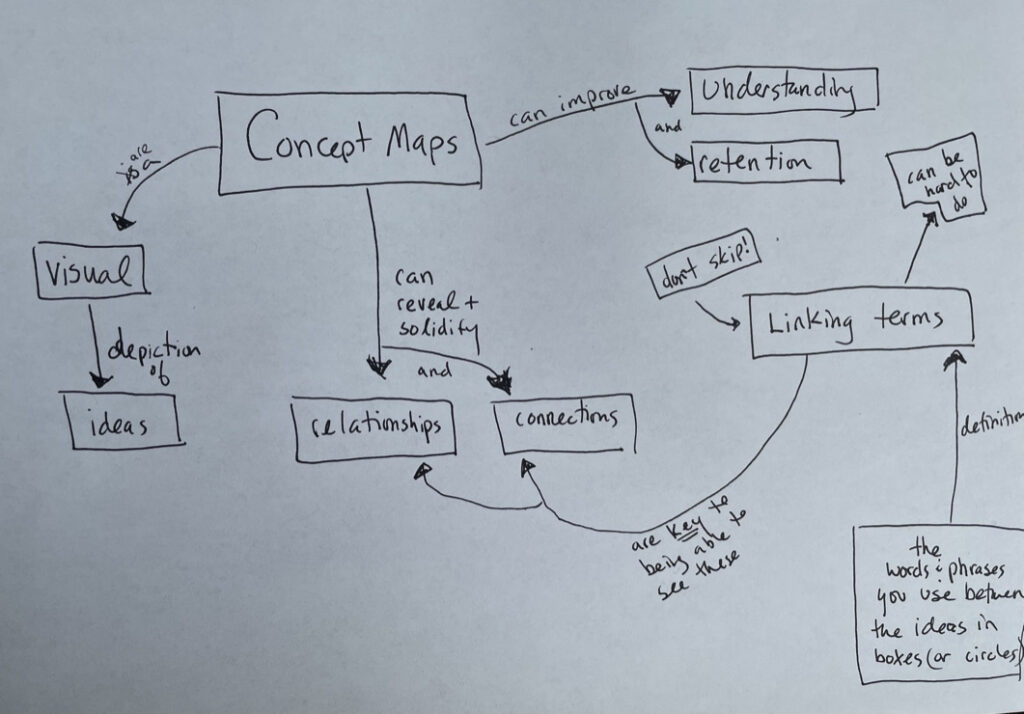Concept maps are a powerful tool for identifying relationships among ideas you learn in class. Understanding these relationships and depicting them visually can help you learn course material at a much deeper level and retain it better, too.
Concept maps are highly personalized and provide an opportunity to organize course material in a way that makes most sense to you.
The main point is to end up with a diagram of all of the important ideas from your class, with terms you add that describe how the ideas are connected to each other. (Some students find that adding these “linking terms” is one of the most challenging part of making a concept map- actively deciding how the ideas are related is key to the effectiveness of concept maps, so don’t skip the linking terms.)
Concept maps can be helpful learning tools in just about any class: STEM, humanities, social sciences, languages, even the arts!
There are many ways to make concept maps, find an approach that works for you.
Here’s the general idea:
1. Start by brainstorming the main big-picture ideas you want to study.
- This is not a list where the order matters, it’s just a brain-dump list.
- Look through chapter headings, lecture notes, and other class material to make sure you haven’t forgotten anything major.
- You can make your list digitally, with pencil and paper, on note cards, or even on small scraps of paper.
2. Choose an idea from your brain-dump list. It can be an idea that:
- you think is important (the title of the chapter or lecture, for example),
- was covered in class most recently,
- you feel most confident about,
- or even just a random one.
3. Put that idea down on paper or on a whiteboard or chalkboard, sort of in the middle. People usually like to but a box or circle around each term—it helps the terms stand out, and it’s oddly satisfying.
4. Now, go through your list of terms.
- What other terms are connected in some way to the one you just used?
- What sorts of relationships do you see?
- The relationship could be a hierarchy, a timeline, small things going to large things, or something else.
- You might not know what relationship you’re going to identify until you look at your list of terms!
- If you’re feeling stuck this is a great time to work with peers or go to office hours.
- You might identify different relationships than people you’re studying with, that’s ok. It can be useful to try to understand why your study partners are thinking differently than you. You don’t necessarily need to agree, but do check to make sure you’re not operating with misconceptions or misunderstandings of the material.
5. Come up with “linking terms” that explain how you see the ideas being related to each other.
- Linking terms are important for seeing relationships and connections.
- If you can’t come up with a linking term for an idea, try moving the idea around to different spots until you can.
6. Arrange and re-arrange all of the ideas you identified on your brain-dump list until the way you have them organized makes sense to you.
- You may find you want to hold off using some ideas for a different concept map, and/or you may find you want to add some you hadn’t thought of initially.
7. When you are studying for exams it can be effective (and for some people also super fun) to geek out and make giant concept maps that put together smaller concept maps you’ve made throughout the semester.
©Cornell University Learning Strategies Center
References:
Holschuh, J. and Nist, S. (2000). Active learning: Strategies for college success. Massachusetts: Allyn & Bacon.
Javonillo, R., & Martin-Dunlop, C. (2019). Linking Phrases for Concept Mapping in Introductory College Biology. Bioscene: Journal of College Biology Teaching, 45(3), 34–38.
Would you like to learn more?
- Use of Concept Mapping to Improve Problem Solving
- Concept Mapping: An Effective, Active Teaching-Learning Method
- The Effect of Concept Mapping to Enhance Text Comprehension and Summarization
- The Effect of Concept Mapping on Students’ Learning Achievements and Interests
- Linking Phrases for Concept Mapping in Introductory College Biology


